While not all plants are adapted to the wet conditions of zone 6, with the average winter temperatures of -10°F to -0°F (-23°C to -18°C), numerous plant species have evolved to flourish in these moist areas. Without further ado, let’s get to know these gorgeous plants and shrubs for wet areas in Zone 6 and get ready to create a vibrant garden that can withstand these natural characteristics!
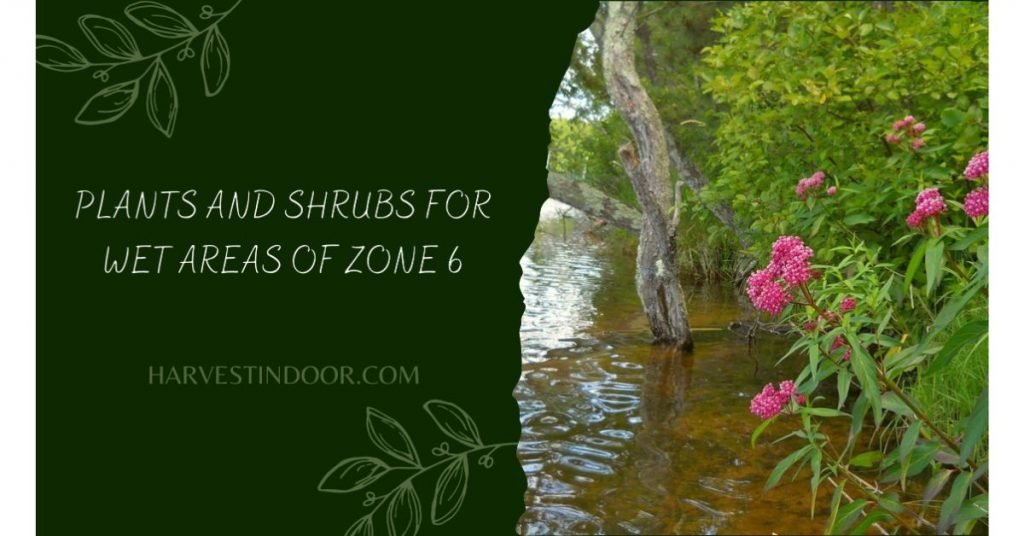
Table of Contents
Understanding Zone 6 and Wet Areas
Zone 6 encompasses several states within the United States, where average minimum winter temperatures can range from -10°F to 0°F (-23.3°C to -17.8°C). This zone is known for its diverse climates and varying environmental conditions, presenting unique challenges for gardening, particularly in wet areas. Let’s explore some of the states within Zone 6 and the specific challenges they face:
- New York: In parts of upstate New York, wet areas can be found near the Great Lakes, such as Lake Ontario. These areas often experience heavy snowfall during winter, resulting in wet soil conditions when the snow melts. Poor drainage and clayey soils are common challenges faced by gardeners in this region.
- Pennsylvania: Wet areas in Pennsylvania can be found in various regions, including the Pocono Mountains and areas along the Delaware River. These areas are prone to higher rainfall and have clay-rich soils, which can lead to waterlogging and drainage issues. Additionally, the state experiences significant variations in temperature and weather patterns, posing challenges for plant selection and survival.
- Ohio: Ohio has wet areas scattered throughout the state, especially in regions near Lake Erie and the Ohio River. These areas often have high water tables and clay soils, making drainage a critical concern. The state’s fluctuating temperatures and occasional heavy precipitation can further impact the moisture levels in these areas.
- Illinois: Wet areas can be found in Illinois, particularly in the northern and central regions of the state. These areas are influenced by the presence of the Great Lakes and the Mississippi River. The heavy clay soils in this region can lead to poor drainage, while the varying weather patterns, including cold winters and hot summers, pose challenges for selecting shrubs that can withstand these extremes.
- Michigan: Michigan, with its proximity to the Great Lakes, has numerous wet areas along the coastlines and inland lakes. Excessive rainfall and snowmelt can result in saturated soils, and the presence of sandy or clay soils adds to the challenges faced by gardeners. The state’s wide temperature ranges, from frigid winters to hot summers, also impact plant selection and overall plant health.
- Indiana: Wet areas in Indiana can be found near the Ohio River and in regions with poorly drained soils. These areas are prone to waterlogged conditions, especially during heavy rains or when snow melts. The state’s continental climate, with cold winters and hot summers, necessitates careful consideration of shrub varieties that can thrive in both wet and extreme temperature conditions.
It’s important for gardeners in these states within Zone 6 to be aware of the specific challenges related to wet areas, such as poor drainage, clayey or sandy soils, and fluctuating moisture levels. By selecting shrubs that are well-adapted to these conditions and implementing proper planting and maintenance techniques, gardeners can successfully cultivate thriving landscapes in these wet areas.
Perennial Plants for Wet Areas Zone 6
Swamp Milkweed (Asclepias incarnata)
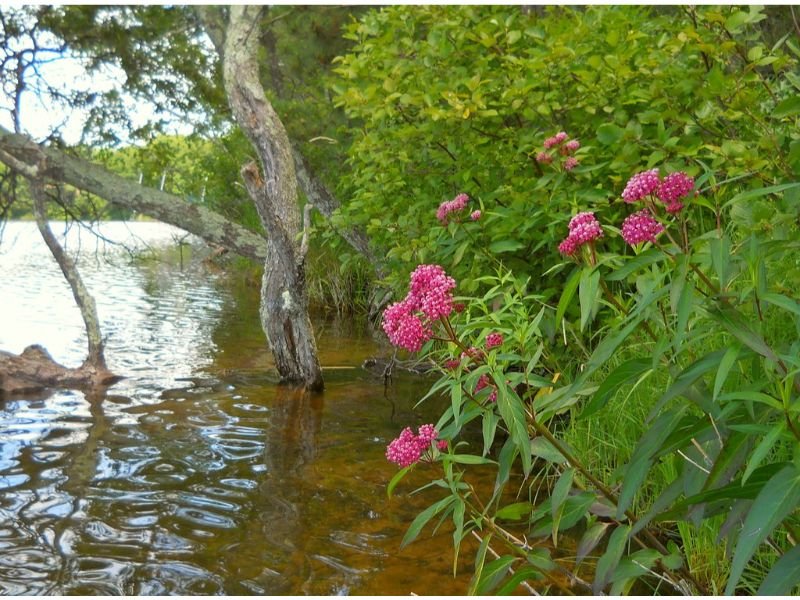
Mature Height: 0.9 to 1.8 meters.
Unique Plant Traits: Swamp milkweed is an essential host plant for rare and endangered monarch butterflies.
With eye-catching deep magenta or pinkish-purple tiny flowers that typically bloom from June to August, this native to North America is truly a feast for both human and pollinator eyes. Swamp milkweed is a low-maintenance plant that mostly doesn’t need pruning or extensive care–so plant lovers who are not experts in pruning, this one is made for you.
Marsh Marigold (Caltha palustris)

Mature Height: 0.3 to 0.6 meters.
Unique Plant Traits: Marsh marigolds are wetland plants that are often found in marshes, swamps, or streams. These plants are also early bloomers.
Although nicknamed marigolds, marsh marigolds are not part of the Asteraceae (daisy) family, but rather the buttercups (Ranunculaceae) family. Another hassle-free plant for wet areas in Zone 6, marsh marigolds can thrive in both direct sun and partial shade. As beautiful as they look, marsh marigolds contain low toxicity, so handle these beauties with extra caution and ensure to not digest any part of it.
Cardinal Flower (Lobelia cardinalis)
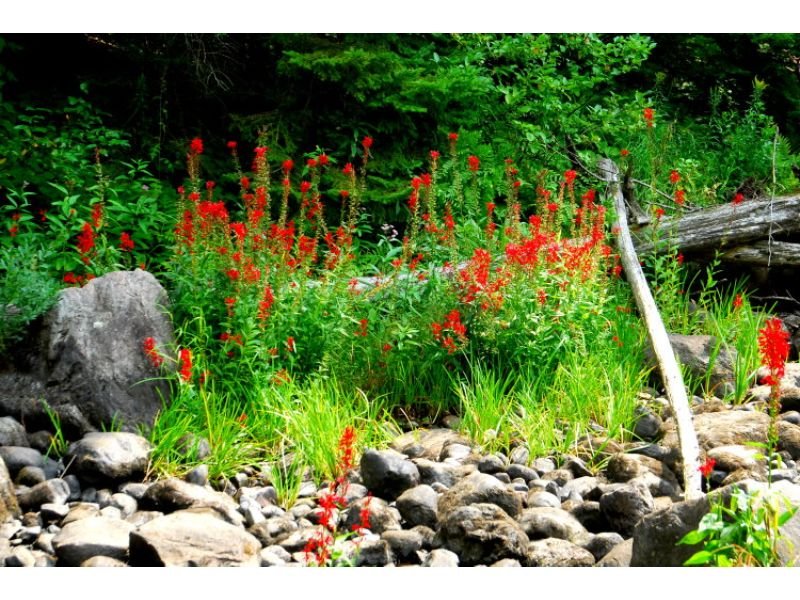
Mature Height: 0.6 to 1.2 meters.
Unique Plant Traits: Cardinal flowers are favored for their striking red colors that look like cardinal birds’ fur. They’re also highly attractive to hummingbirds.
Cardinal flowers require soil that is rich in organic matter to perform the best. These plants for wet areas in zone 6 go dormant in winter and come back in spring where new growth emerges. Although cardinal flowers are believed to treat illnesses such as fever, cramps, and stomach upset, it’s important to note that these plants contain toxic compounds like lobeline.
Small Shrubs for Wet Areas Zone 6
Virginia Sweetspire (Itea virginica)

Mature Height: 1 to 1.5 meters.
Unique Plant Traits: Virginia sweetspire produces fragrant blooms that can be reminiscent of honey or a mild floral aroma.
Virginia sweetspire features glossy, medium to dark green, oval-shaped foliage that is serrated along its edges. The white blooms of these compact perennial shrubs for wet areas zone 6 are elongated in clusters known as ‘panicles’. One of the best things about growing Virginia sweetspire is that they generally do not face significant pests or disease problems.
Ninebark (Physocarpus opulifolius)
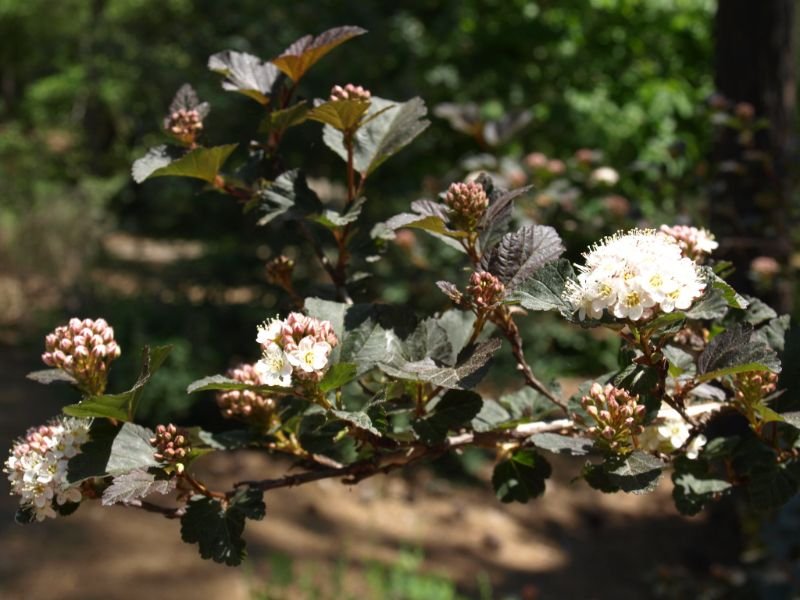
Mature Height: 1.5 to 3 meters.
Unique Plant Traits: Ninebark has exfoliating bark that peels off in layers, with many cultivars available including the one with dark burgundy leaves.
Ninebark is a versatile small shrub that is characterized by palmate and lobed leaves. The blooms appear in clusters of corymbs-like that are known to attract bees. They’re excellent plants for wet areas of Zone 6 due to their ability to control erosion with dense growth habits and extensive root systems. When it comes to soil types and soil pH, ninebarks are also not picky either.
Water-loving Large Shrubs for Zone 6
Winterberry (Ilex verticillata)
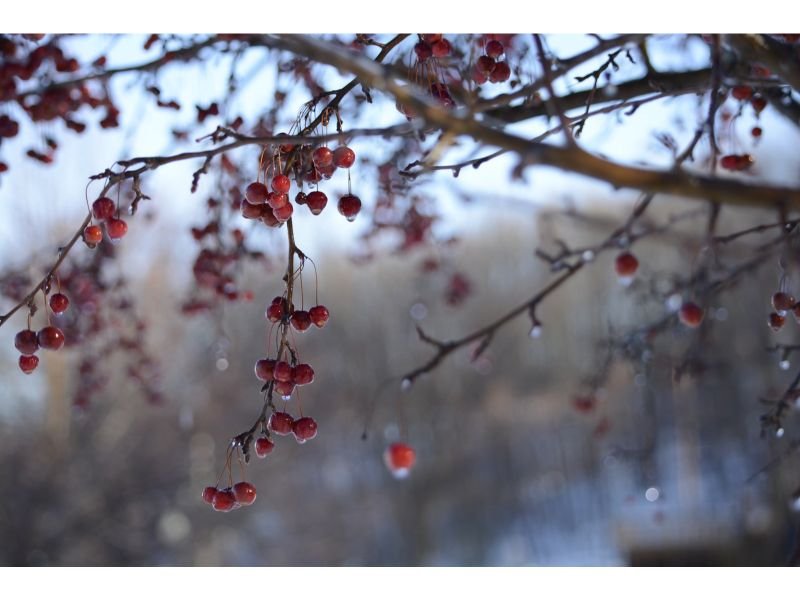
Mature Height: 1.5 to 3 meters.
Unique Plant Traits: Winterberries are either male or female. Female winterberries produce berry-like fruit, while males produce flowers.
Nothing makes winterberries happy than slightly acidic, moist, and well-drained soil. They also need a daily dose of at least 6 hours of direct, bright sun for optimum growth. Although mostly known to be disease-free large shrubs, they’re still susceptible to problems such as root rot, powdery mildew, and leaf spot.
Swamp Magnolia (Magnolia virginiana)
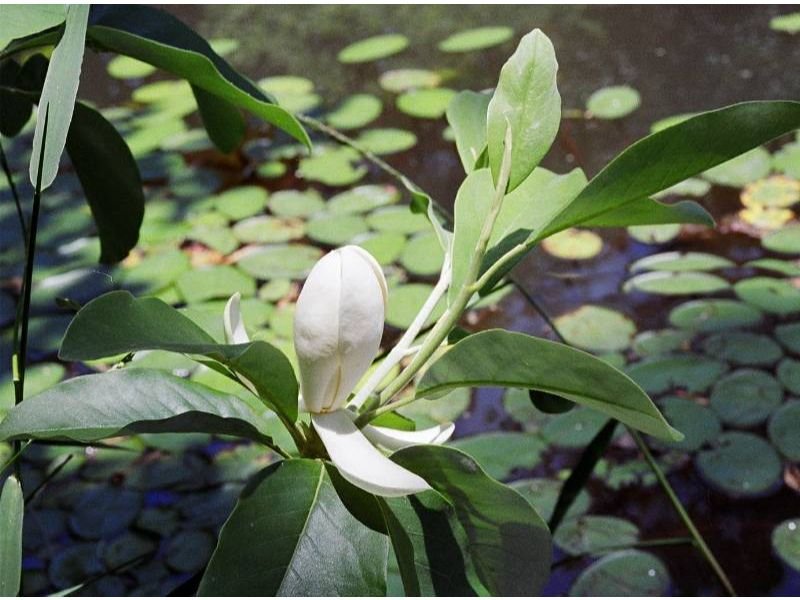
Mature Height: 4 to 12 meters.
Unique Plant Traits: Swamp magnolias are known for their evergreen, glossy dark-green foliage that lasts throughout the year.
As the name suggests, swamp magnolias are well-suited as plants for wet areas in Zone 6 due to their ability to thrive in moist and boggy soils. Same with winterberries, swamp magnolias exhibit dioecy, meaning you can’t find both male and female specimens in one individual plant. Another standout feature of swamp magnolias is their creamy-white blooms.
Shade-loving Plants for Wet Areas Zone 6
Yellow Rocket Cress (Barbarea vulgaris)
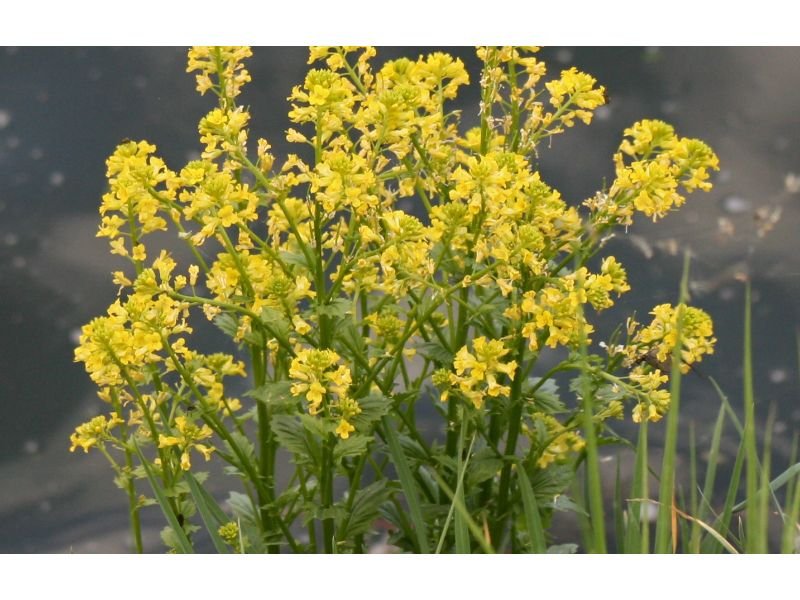
Mature Height: 0.3 to 1 meter.
Unique Plant Traits: Yellow rocket cress features edible leaves that are bitter and slightly peppery in taste.
Also known as bittercress, yellow rocket cress needs to be in constant moisture to protect its delicate roots. The plant, however, tolerates almost any kind of soil, including loam, sandy, and even clay soils. It highlights glossy, dark-green lobed foliage that creates a stunning color contrast with the bright yellow, tiny blooms. Astringent in taste, but this plant is known for its medicinal purposes to soothe skin, as a diuretic, and as an expectorant.
Pink Turtlehead (Chelone lyonii)
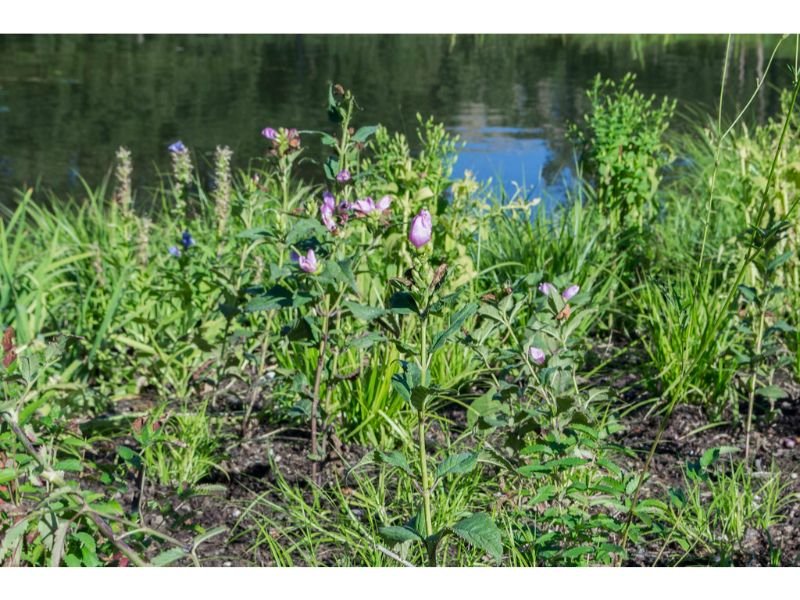
Mature Height: 0.6 to 1.2 meters.
Not only will pink turtlehead flourish in wet areas of Zone 6, but they also make spectacular additions to ponds, boggy, or any other water-soaked areas–thanks to the breathtaking blooms and contrasting foliage. While categorized as a shade-loving plant, pink turtlehead can be grown in areas that receive bright sun too.
Swamp Sunflower (Helianthus angustifolius)

Mature Height: 1 to 2 meters.
Unique Plant Traits: Swamp sunflowers are part of the aster family that is known to be late bloomers, as they bloom in late summer to early fall.
Swamp sunflowers are native to America that, similar to pink turtleheads, tolerate bright areas with direct sun. To successfully grow these herbaceous plants for wet areas in Zone 6, you need to provide regular watering or they would likely struggle to thrive. Swamp sunflowers only tolerate a short period of drought but would say yes to any type of soil as long as it’s moist.
What Are Some Common Problems for Wet-soil Plants of Zone 6?
With the right selection, gardening in these challenging areas would likely not cause you any crucial problems. Nonetheless, there are numerous problems for these plants in wet areas in Zone 6 that you still need to keep an eye on. Two of the most common issues are root rot and fungal problems. You need to ensure proper drainage and regularly check out for any kind of suspicious signs of diseases such as wilting leaves and stunted growth.
Small culprits like snails and slugs, which also love damp areas, can cause other damage to the plants. To get rid of these unwanted pests, implementing pest control measures along with regular soil testing is highly recommended.
Planting Techniques for Wet Areas
- Dig a hole: Dig a hole that is wider than the root ball of the shrub and slightly shallower than its height.
- Gently loosen the roots: Carefully loosen the roots of the shrub before planting to encourage healthy growth.
- Place the shrub: Position the shrub in the center of the hole, making sure it sits at the same level as it was in the container.
- Backfill the hole: Fill the hole with soil, gently tamping it down to eliminate air pockets.
- Water thoroughly: After planting, water the shrub thoroughly to ensure proper hydration.
Providing Adequate Watering and Drainage
In wet areas, finding the right balance of water is crucial. While the soil may already be moist, shrubs still require regular watering during dry spells. Additionally, ensuring proper drainage is essential to prevent waterlogged roots. Consider the following tips:
- Monitor soil moisture: Regularly check the moisture level of the soil. Stick your finger into the ground near the shrub’s roots to determine if watering is necessary.
- Adjust watering frequency: If the soil is consistently wet, reduce the frequency of watering. Only water when the top inch of soil feels dry.
- Improve drainage: If the area has poor drainage, consider incorporating organic matter, such as compost, into the soil to enhance its structure and drainage capacity.
Mulching for Moisture Retention
Applying mulch around shrubs in wet areas offers multiple benefits, including moisture retention, weed suppression, and temperature regulation. Follow these guidelines for effective mulching:
- Choose the right mulch: Opt for organic materials like wood chips, shredded bark, or straw. Avoid using plastic or rubber mulch, as they hinder water absorption.
- Apply an even layer: Spread a 2 to 4-inch layer of mulch around the shrub, leaving a small gap around the stem to prevent rotting.
- Replenish mulch: Over time, the mulch will decompose. Replenish it annually to maintain a consistent layer and reap its benefits.
Pruning and Maintenance
Regular pruning and maintenance ensure the health and aesthetics of shrubs in wet areas. Follow these guidelines:
- Prune in dormant seasons: It’s best to prune shrubs in late winter or early spring before new growth emerges.
- Remove damaged or diseased branches: Prune any branches that are dead, damaged, or affected by diseases or pests.
- Shape the shrub: Trim the shrub to maintain its desired shape and size. Be mindful not to prune excessively, as it can affect flowering and overall growth.
Final Verdict
Challenging habitats like wetlands might be avoided by most plant enthusiasts. But with some caution and picking the right plants, gardening in these areas can be equally rewarding too! Since we’re blessed with plants for wet areas in zone 6 such as swamp marigolds and the moist-loving shrub ninebark, who says that these areas are meant to be evaded forever?

New author in the hood. Loves gardening and flowers are my spirit animals (yes I know they are not animals but I insist). I will be covering most of the flowers’ topics here and occasionally random though as well.






